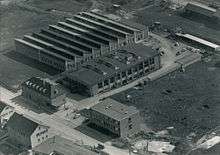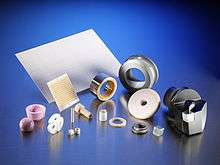CeramTec
CeramTec manufactures and develops advanced ceramic components. The products are used in many different applications, especially in medical technologies, automotive manufacturing, electronics, equipment and machine construction, defense technologies, and chemical industries. The company headquarters are in Plochingen, Baden-Württemberg, Germany.
| Public Company | |
| Industry | Advanced Ceramics, Technical Ceramics |
| Founded | 1996 / 1903 |
| Headquarters | Plochingen (Headquarters) , Germany |
Area served | Worldwide |
Key people | Hadi Saleh (CEO) |
| Services | Ceramic Engineering |
| Revenue | EUR 600 million (2018) |
Number of employees | 3,500 (2018) |
| Parent | BC Partners |
| Website | http://www.ceramtec.com/ |
The company is present around the globe and has production sites and sales offices in the world’s most important markets. In Germany, the main sites are Plochingen, Lauf and Marktredwitz in addition to the company’s other German sites in Ebersbach, Lohmar, Wilhermsdorf and Wittlich.
The company is a member of the Ceramic Industry Association (German: Verband der Keramischen Industrie e.V. - VKI).
History

_in_2005.jpg)
The founding of CeramTec goes back to the year 1903, when the Thomas factories (Thomaswerke) were founded at the Marktredwitz site, and which were taken over by Philipp Rosenthal & Co. AG in 1908. In 1921 Philipp Rosenthal & Co. AG began cooperating with AEG in the development of technical porcelain for early industrial applications of ceramic materials. The two companies intensified this partnership in the area of technical ceramics in 1936, resulting in the foundation of Rosenthal Isolatoren GmbH, also known as RIG.
With the intention of manufacturing technical ceramics, they reorganized their cooperation in 1971. The result was the company Rosenthal Stemag Technische Keramik GmbH, which was renamed Rosenthal Technik AG in 1974. In 1985 Hoechst AG acquired the company and from that point on operated it under the name Hoechst CeramTec AG. Cerasiv GmbH, a company based in Plochingen, took over Hoechst CeramTec AG in 1996 and the newly formed company received the name CeramTec AG.
The site in Lauf an der Pegnitz has its roots in STEMAG AG (Steatit-Magnesia Aktiengesellschaft), founded in 1921. Following an initial incorporation into AEG in 1970, the company merged into Rosenthal Stemag Technische Keramik GmbH in 1971 as part of the reorganization of the partnership between Rosenthal and AEG.
Südplastik Gummi- und Kunststoffverarbeitung GmbH began operations at the Plochingen site in 1951. Feldmühle AG took over the company in 1953, renaming it Südplastik und -keramik GmbH (SPK). Feldmühle AG refocused its ceramic activities in 1991 in the newly founded Cerasiv GmbH, but then quickly sold it in 1992 to Metallgesellschaft AG, which integrated the company into its subsidiary Dynamit Nobel AG. Cerasiv GmbH’s acquisition of Hoechst CeramTec AG followed in 1996, resulting in the founding of CeramTec AG as a Metallgesellschaft AG (mg technologies AG) company.[1]
Metallgesellschaft AG’s subgroup Dynamit Nobel AG broke away from Metallgesellschaft AG in 2004. KKR, an American private equity firm, became the main buyer, integrating parts of Dynamit Nobel AG into Rockwood Holdings Inc. In the process, the US-based Rockwood group took over ownership of the CeramTec AG group.[2] CeramTec continued to grow, acquiring and integrating Emil Müller GmbH (Wilhermsdorf, Germany) into the company as a subsidiary in 2007. A further acquisition followed in 2008; ETEC Gesellschaft für technische Keramik mbH also became a subsidiary and was renamed CeramTec-ETEC GmbH.
In 2013, Rockwood divested several of its companies and the CeramTec group was acquired by the British private equity firm Cinven.[3]
In April 2017, CeramTec agreed to acquire the UK electro-ceramics business UK Electro-Ceramics, consisting of two manufacturing sites at Ruabon and Southampton, from Morgan Advanced Materials PLC.
Applications and products

Applications range from ceramic components for artificial hip and knee replacements to dental ceramics, seal and regulator discs as well as cartridges in sanitary fittings, inserts for metalmachining, substrates for electronic circuits, appliance and mechanical components, fuse components, protection components, ceramics for ballistic protection of persons and vehicles, anti-wear components, dipping formers for surgical gloves, to piezoceramics as the key components of sensor and actuator technology products.
Material and product brands
- Aloslide - inrun for giant ski jumps
- Alotec - anti-wear and ballistic protection components
- Alunit - aluminium nitride ceramic for electronic substrates
- Biolox - prosthetic components for hip and knee joints
- Ceramaseal - vacuum-tight ceramic/metal components
- Ceramcool - ceramic heat sinks for high-power LEDs and high-power electronics
- Ceramdisc - seal and regulator discs for sanitary fittings
- Cyrol - ceramic rolling elements based on silicon nitride ceramic
- PERLUCOR - transparent ceramic for special windows like windows for high-temperature applications up to 1800 degree Celsius and more, or transparent ballistic vehicle protection[4]
- ROCAR - silicon carbide ceramics for industrial applications
- Rubalit - aluminium oxide ceramic for electronic substrates
- SONOX - piezoceramic material for sensor and transducer components
- SPK - inserts for turning and milling cast components and toughened steels
Main materials
Oxide ceramics
- Aluminium oxide
- Zirconium oxide
- Aluminium titanate
- Silicate ceramic
- Piezoceramic
Non-oxide ceramics
- Silicon carbide
- Silicon nitride
- Aluminum nitride
Composite materials
- Metal Matrix Composite
- Ceramic Matrix Composite